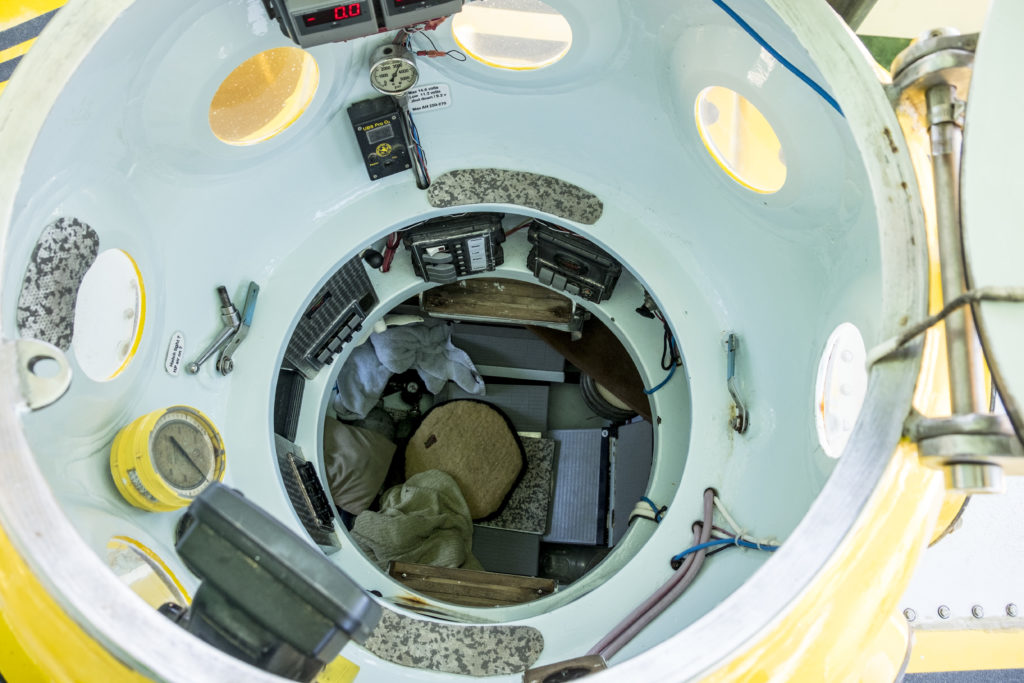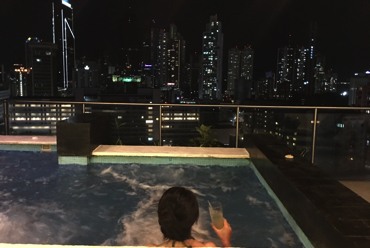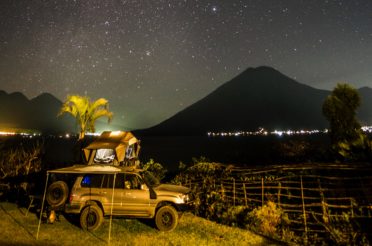We were having lunch and drinking a beer, while reading up on Honduras, when Susan mentioned something that caught her eye: “oh, there’s a guy called Karl on Roatan island built a small submarine himself and can take passengers down to the up to 2,000 feet.” Tolik, who has joined us on the trip 2 days prior, and I did a double take: “What was that?”
Within an hour, we dug up his number and a call was made to Karl. After a brief conversation, we re-arranged our plans and were on our way to meet Karl Stanley, the guy who was mentioned in the book to undertake one of the most exhilarating and unexpected experiences of our lives.
Karl’s story begins at a young age of 15 at his parents’ backyard, back in Ridgewood, NJ, when he first started to build submarines. He brought the prototype of his first sub with him to college in Florida and continued to work on it. Although having majored in History and with no “official” engineering training, he went on complete his first sub for a total cost of about $20,000 and successfully took it for the first dive to a depth of about 15 feet.
Emboldened by the success, but not quite sure what to do with it next, he ended up taking it to a Florida marine show where, by chance, he crossed paths with a business owner from Honduras who owned a small resort on Roatan island, about 30 miles of the coast of mainland. Thinking that it would serve as a way to draw people in, he invited Karl to set up a base of operation there.
Karl moved to Roatan and setup a submarine operation where he’d take paying customers down to depths of 725 feet, while beginning to think about how to improve his design and capabilities.
Over a course of a few years that followed, he built a new submersible called Idabel that was designed to go up to 3,000 feet under the sea level. To put this in perspective, a typical diver will usually go to about 100 feet, a typical military submarine will cruise at 200 to 400 feet, and while there are other submarines that can go deeper, the chances of an average person of hitching a ride on them are slim to say the least. Only two other submarines worldwide are open for public and his is the only one that will go to such depths..
Idabel was designed and built entirely by Karl at a cost of less than $200,000, which makes it an order of magnitude cheaper than any other sub designed for scientific or military purposes. It comes with a downside, though – mainly that it would not pass any official certification design and maintenance standards in the U.S. or developed countries nor could it be properly insured. This is part of the reason that it’s based in and operates in Honduras – where its flexible regulatory climate is part of the appeal.
Throughout the entire development process, Karl tested his submarines himself. It certainly takes nerves of steel and a certain level of chutzpah to take that first dive down to the depths where almost no other people have gone to before and you’re really on your own. As for alleviating the concerns of his passengers who came after and were worried about insurance, his statement rings reasonable: “Your only insurance is that I’m coming with you”. After all, if something were to go wrong at those sort of depths, insurance wouldn’t help much.
Above the Sea Level
After our original call to Karl, where he picked up himself and agreed to take us down to a 2,000 feet dive 4 days later, we arranged to meet with him at 10am on a sunny Wednesday in Roatan. Typically, his submarine is designed for 2 passengers and a pilot (himself), but he was flexible enough to let us know that all 3 of us can go as long as we can fit inside the tiny compartment and our combined weight is under 460 pounds (we clocked in at 395).

As we approached the dock with a bright GO DEEPER sign on the roof, Idabel came into view. Bright yellow and small, it was hanging a few feet above the water in its designated dock space. Having only previously seen submarines in an occasional museum that would showcase 20, 30, or 40-year old ones built for military use, Idabel was… different. Painted bright yellow, in a shape that would most closely resemble a character from a cartoon, and with a few homemade patches over its exterior, it did not feel like a cutting-edge, one-of-the-world’s few deep submersibles.






Right next to it, a generator was running while filling up the oxygen tanks for the dive ahead. Karl appeared a few moments later, with a drill in hand to take care of some last minute maintenance. After the introductions and quickly checking up on the oxygen status, he asked if we were in a rush, as he needed to hop on a bike to get a replacement battery for the oxygen reader that just failed. We were in no rush, so he cycled off, while we continued to explore the submarine from the outside.
Homemade and submarine don’t appear in the same sentence often, so it was fascinating to see how it came together. Clocking in at just 13 feet long, 6 1/2 feet wide, and 7 feet tall, it’s comparable to a small airplane sans the wings.
The front consisted of a small sphere for the passengers with a 30-inch diameter dome window in front and a 15-inch flat window on the floor to provide the maximum visibility. Within the compartment was a small bench for the passengers – typically 2, although the record was 6 people.
The middle section was where the pilot, Karl, was stationed. Standing during the operation, he would have a 360 degree view through 9 small windows in the wheelhouse.
The sub was equipped with 4 horizontal and 2 vertical motors and electric batteries for about a 10-mile range. It’s got a full set of lights, as under 1,200 feet, sunlight no longer penetrates the ocean and it becomes pitch black. And it also featured 3 days of emergency life support, although it wouldn’t be particularly helpful as it’s those depths, as it’s impossible to communicate with the outside world and moreover, there are very few submarines in the world that can go to those depths to recover you and none of them are particularly close by.
Karl returned shortly thereafter and gave us a quick run through on the route. We’d motor out a short distance away from the shore and then begin our descend along the Cayman trench. In total, we’d spend about 4 hours underwater – with most of the time at depths between 1,500 and 2,100 feet. After a short run-through the route, it was time to get in. Notably, the safety component of the presentation was missing, but as one of Karl’s shirts states “don’t worry, I do it all the time”, we felt fairly comfortable with the process.
Susan went through the hatch first, followed by Tolik and myself. We crawled through the small passageway into the passenger compartment and squeezed together on the bench. It was noticeably warm inside, although 2 small fans on both sides would provide a much-appreciated air circulation. The front window would bulge out quite a bit, providing a view not just forward, but down, up and to the sides as well.

Karl lowered Idabel into the water and slowly pushed off the dock…
<Part 2 is coming next week! In the meantime, check out our video from the dive below!>








Leave a Reply